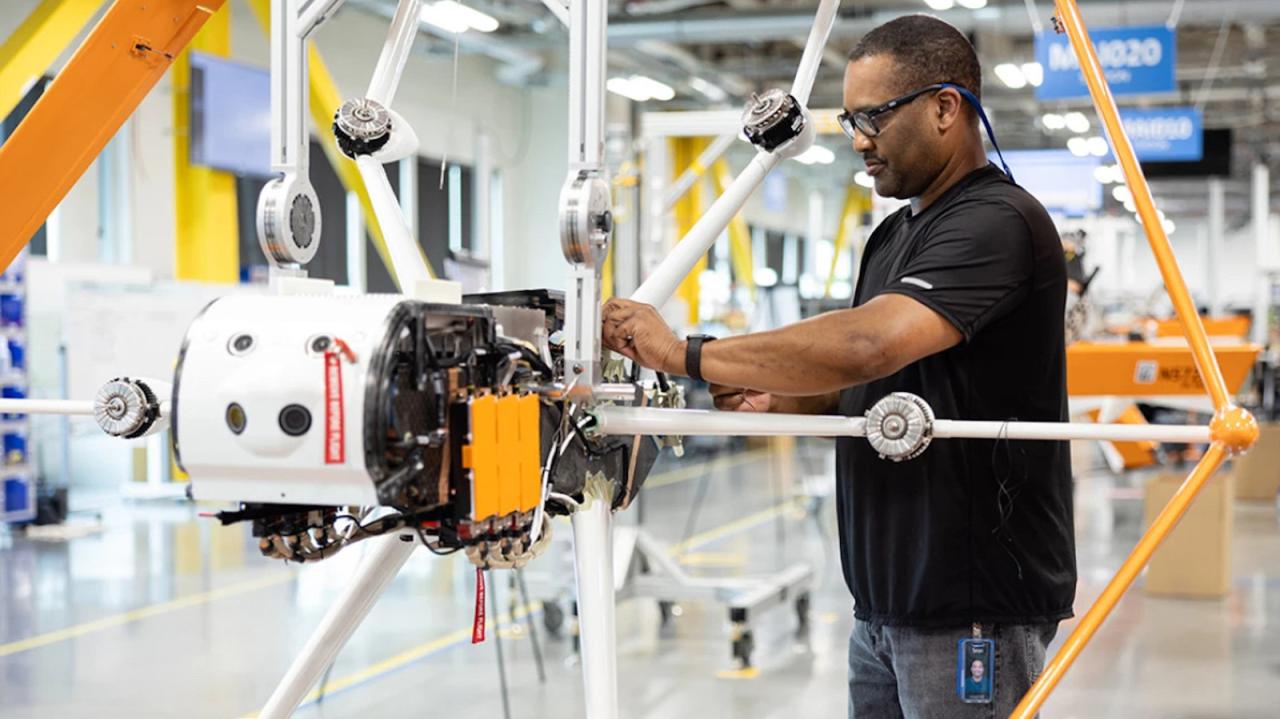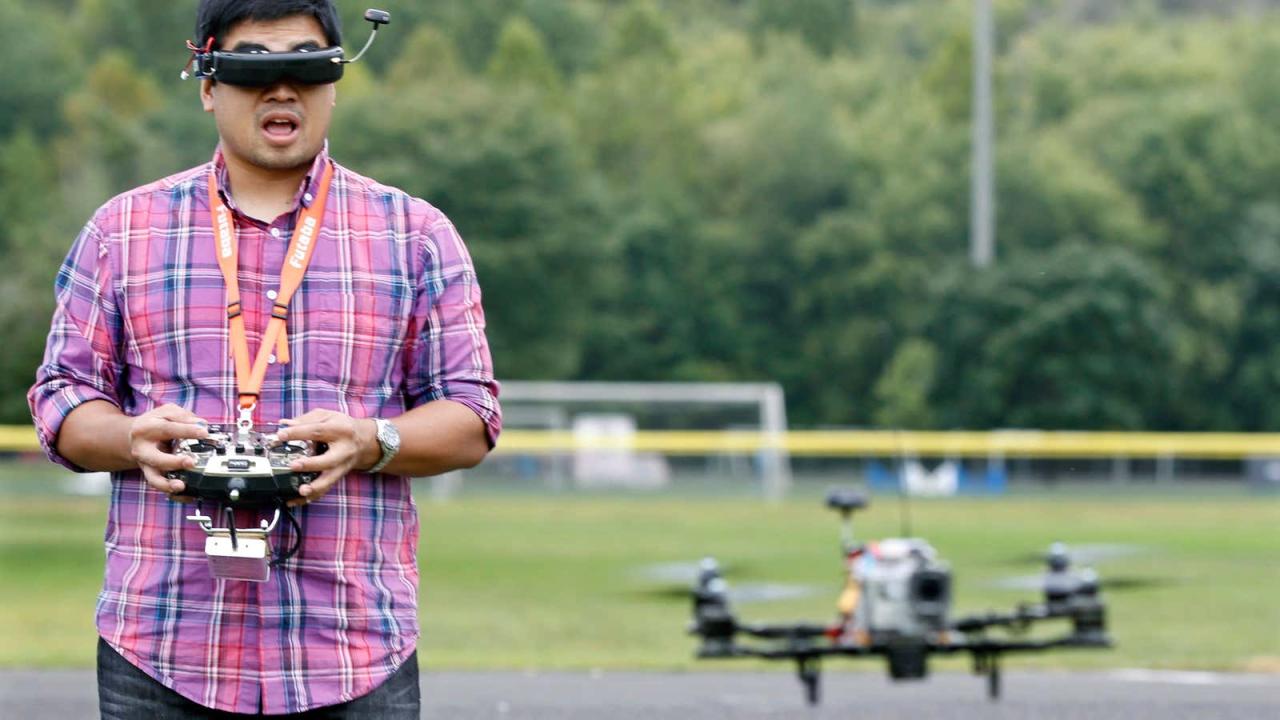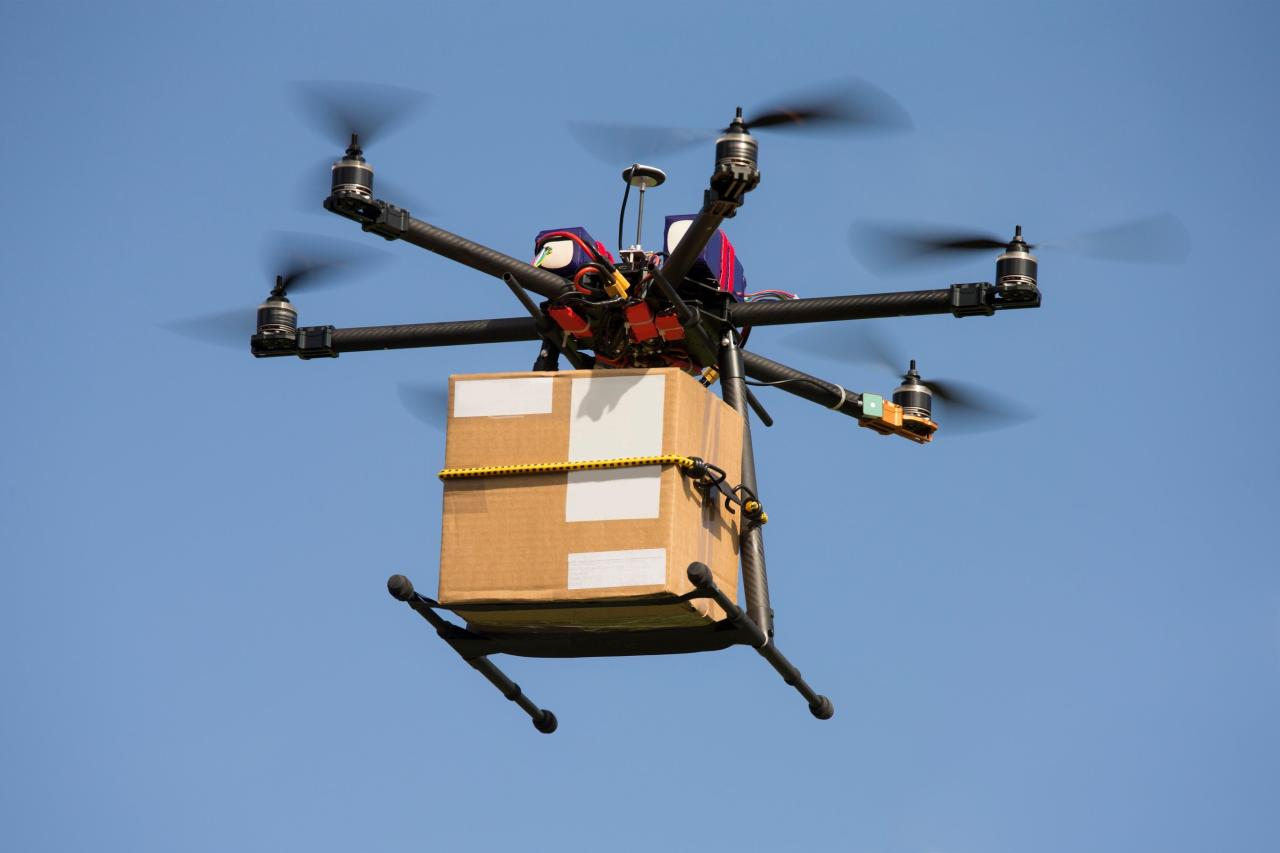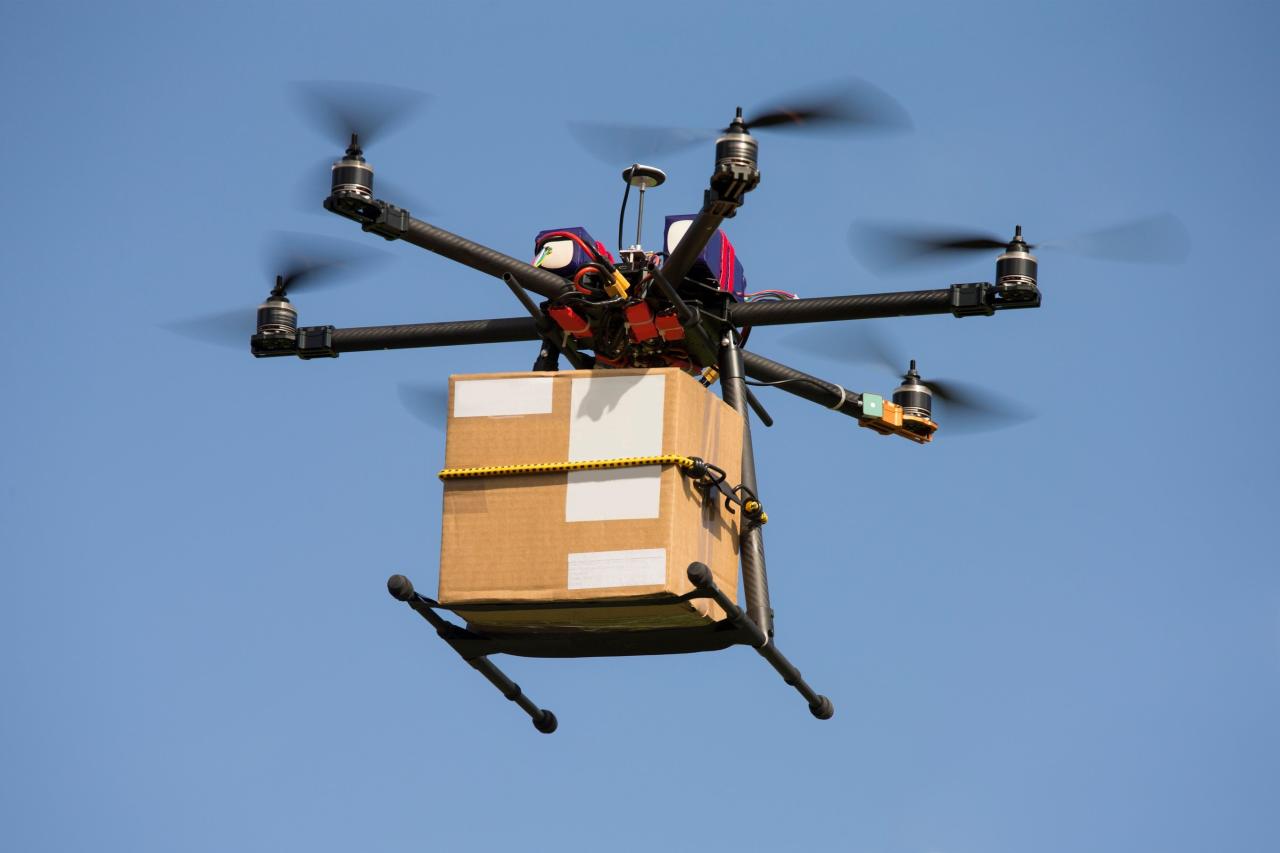Amazon drone delivery locations are rapidly expanding, revolutionizing how we receive packages. This exploration delves into the current status of Amazon’s drone delivery program, examining its geographical reach, the types of goods delivered, and the underlying technology. We’ll also investigate the factors influencing location selection, including logistical challenges, regulatory hurdles, and cost-effectiveness. Looking ahead, we’ll speculate on future expansion plans and discuss the potential impact on communities, considering both economic and environmental consequences.
Finally, we’ll examine how technological advancements will shape the future of drone delivery.
Understanding the intricacies of Amazon’s drone delivery network is crucial for businesses and consumers alike. This comprehensive overview provides a clear picture of the current landscape and potential future developments, offering valuable insights into this rapidly evolving sector.
Current Amazon Drone Delivery Program Status: Amazon Drone Delivery Locations
Amazon’s drone delivery program, officially known as Amazon Prime Air, is steadily expanding its reach and capabilities, though it’s still in a relatively early stage of widespread deployment. While not yet a ubiquitous service, it represents a significant step towards faster and more efficient delivery methods.Amazon’s drone delivery program currently operates within a limited geographical scope. The service is not available nationwide, nor even in most major cities.
Instead, it focuses on specific, carefully selected locations where the necessary infrastructure is in place and regulatory approvals have been obtained. These areas tend to be suburban or rural, with relatively low population density and manageable airspace. The company strategically chooses these locations to minimize operational complexities and maximize the efficiency of its drone fleet.
Geographical Scope of Amazon Drone Delivery
Amazon Prime Air’s operational areas are limited to a small number of communities. Initially, the program focused on testing and refinement in select areas. The company continues to expand cautiously, adding new locations as technology matures and regulatory hurdles are cleared. Publicly available information on precise locations is often limited, reflecting Amazon’s strategic approach to rollout and competitive considerations.
However, news reports and company statements have indicated operational areas in several states. This gradual expansion allows Amazon to gather real-world data, refine its operations, and address any unforeseen challenges before a broader deployment.
Eligible Items for Drone Delivery
Currently, the range of items eligible for drone delivery is restricted. Amazon focuses on smaller, lighter packages that can be safely and efficiently transported by its drones. These typically include everyday household items, such as over-the-counter medications, snacks, and small electronics. Larger, heavier, or fragile items are not yet suitable for drone delivery due to limitations in the drones’ carrying capacity and the need to ensure safe and undamaged delivery.
This selection prioritizes items that can be reliably delivered within the existing technological constraints of the program.
Technological Infrastructure for Drone Delivery
Successful drone delivery relies on a complex interplay of technological systems. This includes the drones themselves, equipped with advanced navigation and obstacle avoidance systems, as well as sophisticated software for flight planning and management. Crucially, a robust communication network is needed to maintain constant contact with the drones and monitor their flight paths. Amazon utilizes a combination of GPS, cellular, and other communication technologies to ensure reliable connectivity.
Furthermore, dedicated landing zones, often equipped with sensors and cameras for precise landing and package retrieval, are essential. Finally, robust data analysis and security protocols are needed to manage the large amounts of data generated by the drone operations and safeguard the integrity of the delivery process. The system is designed for redundancy and safety, with multiple layers of protection to mitigate risks.
Comparison with Other Drone Delivery Initiatives, Amazon drone delivery locations
Several companies are pursuing drone delivery initiatives, each with its own approach and technological focus. Google’s Wing, for example, has a more established presence in some international markets, offering a wider range of delivery options. Other companies, like UPS and FedEx, are also exploring drone delivery technologies, but on a smaller scale than Amazon. Compared to these initiatives, Amazon leverages its existing logistics infrastructure and vast customer base, giving it a potential advantage in scaling its drone delivery service.
However, the regulatory landscape and technological challenges remain common hurdles for all players in this emerging sector. Each company faces its own set of unique hurdles and opportunities in navigating the evolving regulatory landscape and technological advancements in this rapidly developing field.
Factors Influencing Drone Delivery Location Selection
Choosing locations for Amazon’s drone delivery service involves a complex interplay of logistical, regulatory, and economic factors. Successful implementation requires careful consideration of these elements to ensure efficient and safe operations while maximizing cost-effectiveness.
Amazon’s expanding drone delivery network is pretty cool, right? They’re aiming for super-fast delivery to lots of places. However, the safety aspect is key; check out this article about drone crashes in Paris to see why reliable drone tech is crucial for widespread adoption. Ultimately, the success of Amazon’s drone delivery locations hinges on minimizing incidents like these.
Several key aspects must be carefully weighed when selecting locations for drone delivery. These considerations range from the practical challenges of navigating airspace and infrastructure to the regulatory frameworks governing drone operations in different regions. Furthermore, population density and the existing infrastructure significantly impact the feasibility and economic viability of drone delivery in a given area.
Logistical Considerations for Drone Delivery Locations
Logistical factors are paramount in determining suitable drone delivery locations. These include airspace management to avoid conflicts with manned aircraft, the availability of suitable takeoff and landing zones (often requiring dedicated infrastructure), and the ability to establish reliable communication links between drones and the control center. For example, areas with high-rise buildings or significant obstacles might present challenges for drone navigation, necessitating more sophisticated flight planning and potentially increasing operational costs.
The distance between the distribution center and the delivery locations also impacts flight times and battery requirements, influencing the choice of drones and the overall operational efficiency.
Regulatory Hurdles and Approvals for Drone Delivery
Drone delivery operations are subject to stringent regulations that vary significantly across different jurisdictions. Securing the necessary approvals and licenses can be a lengthy and complex process. These regulations often address aspects like airspace authorization, pilot certification, drone registration, and safety protocols. For instance, obtaining FAA approval for drone flights in the United States involves a detailed application process, including demonstrating compliance with safety standards and obtaining necessary waivers for operations in specific airspace.
International regulations also vary widely, impacting the scalability and global reach of drone delivery programs. Amazon needs to navigate this complex regulatory landscape on a location-by-location basis.
Population Density and Infrastructure Requirements
Population density and existing infrastructure play a critical role in determining the suitability of a location for drone delivery. Higher population densities generally translate into a greater number of potential customers and higher delivery volumes, potentially making drone delivery more cost-effective. However, densely populated areas may also present challenges related to airspace management and the identification of safe landing zones.
Adequate infrastructure, including reliable communication networks and readily accessible landing spots (such as designated landing pads or rooftops), is crucial for efficient drone operations. Conversely, sparsely populated areas might offer less congested airspace but may not justify the investment in infrastructure needed to support drone delivery due to lower delivery volumes.
Cost-Effectiveness of Drone Delivery Across Geographical Locations
The cost-effectiveness of drone delivery varies significantly depending on geographical location. Factors such as distance, infrastructure requirements, regulatory costs, and labor costs all influence the overall economic viability.
| Location | Population Density | Infrastructure | Cost Analysis |
|---|---|---|---|
| Suburban Area (e.g., parts of the US Midwest) | Moderate | Relatively good road network, some need for dedicated landing zones | Potentially cost-effective due to moderate distances and less congested airspace. |
| Urban Area (e.g., Manhattan, New York City) | High | Excellent road network, challenging airspace, need for sophisticated infrastructure for landing zones | Potentially less cost-effective due to high infrastructure costs and complex airspace management. |
| Rural Area (e.g., parts of rural California) | Low | Limited infrastructure, potential need for significant investment in landing zones and communication networks | Potentially less cost-effective due to long distances and high infrastructure investment needed. |
| College Campus (e.g., a large university) | High (localized) | Existing infrastructure (buildings, open spaces), potential for dedicated landing zones | Potentially cost-effective due to concentrated population and manageable airspace. |
Future Expansion Plans for Drone Delivery Locations

Amazon’s drone delivery program, while still in its relatively early stages, shows immense potential for growth. Expansion will likely be a phased process, focusing on strategic locations that offer a balance of high demand, suitable infrastructure, and manageable regulatory hurdles. This will allow Amazon to refine its operations and address challenges proactively before scaling to larger, more complex regions.
So you’re curious about Amazon drone delivery locations? They’re expanding rapidly, but it’s not always clear where they operate. Think about the logistics – it’s a complex network! This reminds me of that whole mystery drone Paris incident; the challenges of managing airspace are pretty evident there, too. Ultimately, knowing where Amazon drones deliver helps us understand the future of efficient package delivery.
Hypothetical Expansion Plan: Phases and Timelines
This hypothetical expansion plan Artikels a three-phase approach for expanding Amazon’s drone delivery network over the next five to ten years. The plan prioritizes areas with existing logistical infrastructure and relatively less stringent regulatory environments, gradually moving towards more challenging territories.Phase 1 (Years 1-3): Focus on expanding within existing operational areas and adding similar regions. This involves increasing drone fleet size, optimizing delivery routes, and enhancing the delivery network’s capacity within the current operational footprint, such as expanding to more suburban areas near current delivery hubs and adding more delivery hubs within these regions.
This phase also includes expanding to similar geographic areas—for example, if the program is successful in a specific type of rural environment, they’d expand to similar rural environments in other states.Phase 2 (Years 3-6): Expansion to strategically selected urban areas with relatively developed drone-friendly infrastructure. This will involve navigating stricter airspace regulations and addressing the complexities of urban environments.
Examples include selecting cities with existing drone testing zones or those showing a high level of public acceptance of drone technology. This phase will also focus on more densely populated suburban areas.Phase 3 (Years 6-10): Expansion into more geographically challenging areas, such as mountainous or remote regions, potentially utilizing advanced drone technologies and improved logistics solutions. This phase might involve partnerships with local governments or organizations to address infrastructure limitations and regulatory challenges.
It could also involve testing specialized drone designs suited for diverse terrains and weather conditions. This could also include international expansion into countries with more permissive regulations and high e-commerce demand.
Potential Challenges in Expanding the Drone Delivery Network
Expanding Amazon’s drone delivery network presents significant challenges across logistical, regulatory, and technological domains. Addressing these challenges effectively will be crucial for the program’s long-term success.
The following list details potential challenges categorized by their nature:
- Logistical Hurdles:
- Maintaining a large-scale drone fleet: This includes issues such as drone maintenance, repairs, and battery management for a large number of drones across multiple locations.
- Efficient route planning and optimization: The complexities of urban airspace and varying delivery demands require sophisticated route planning algorithms to minimize delivery times and energy consumption.
- Scalable infrastructure: Expanding the network requires significant investment in charging stations, maintenance facilities, and control centers.
- Package handling and security: Ensuring secure and efficient package handling from warehouse to drone to customer is critical.
- Regulatory Hurdles:
- Airspace regulations: Navigating complex and evolving airspace regulations varies significantly by region and requires close collaboration with aviation authorities.
- Privacy concerns: Addressing public concerns regarding drone surveillance and data privacy is crucial for public acceptance.
- Liability and insurance: Establishing clear liability frameworks for drone accidents and damage is necessary.
- International regulations: Compliance with diverse international regulations poses significant challenges for global expansion.
- Technological Hurdles:
- Drone technology limitations: Current drone technology has limitations in range, payload capacity, and weather resilience.
- Autonomous navigation and obstacle avoidance: Ensuring safe and reliable autonomous navigation in complex environments is critical.
- Integration with existing systems: Seamless integration with Amazon’s existing logistics and delivery systems is essential.
- Resilience against cyberattacks: Protecting the drone network from cyberattacks is crucial for operational security.
Impact of Drone Delivery on Local Communities

Drone delivery, while offering exciting possibilities for faster and more efficient shipping, presents a complex interplay of benefits and drawbacks for the communities where it operates. Understanding these impacts is crucial for responsible implementation and planning. The effects are multifaceted, touching upon economic activity, environmental sustainability, and the local job market.
Economic Impact of Drone Delivery
The economic effects of drone delivery on a community can be significant. Businesses may experience increased efficiency and reduced delivery costs, leading to potentially lower prices for consumers and increased profitability. This could stimulate local businesses reliant on timely deliveries, such as restaurants or pharmacies. Conversely, existing delivery services like trucking companies might face reduced demand, potentially leading to job losses in those sectors.
The overall economic impact will depend on the scale of drone delivery adoption and the ability of the community to adapt to the changing landscape. For example, a town heavily reliant on traditional courier services might see a temporary dip in employment, while a town with a burgeoning e-commerce sector could experience a boost in related business activity.
Environmental Implications of Drone Delivery
Compared to traditional delivery methods, drone delivery has the potential to offer significant environmental benefits. Replacing large trucks with smaller, electric drones can reduce greenhouse gas emissions and air pollution in congested areas. The reduced reliance on fossil fuels translates directly to a lower carbon footprint. However, the manufacturing and eventual disposal of drones themselves introduce environmental concerns.
The increased frequency of flights could also lead to noise pollution, impacting residents’ quality of life. The environmental impact will depend on factors such as the type of drones used, their operational efficiency, and the overall volume of deliveries. A successful implementation would necessitate sustainable drone design and responsible operational practices.
Effects on Local Employment and Job Creation
Drone delivery will likely create new jobs in areas like drone maintenance, repair, and operation. Specialized skills in drone piloting, software development, and logistics management will be in demand. However, as mentioned earlier, the transition could also lead to job displacement in traditional delivery sectors. The net effect on employment will depend on the rate of job creation versus job displacement, as well as the community’s ability to reskill and retrain its workforce.
A successful transition requires proactive strategies to support workers affected by automation, potentially through retraining programs focused on emerging drone-related technologies.
Visual Representation of Impacts on a Sample Community
Imagine a small town named Oakhaven. On one side of a scale representing the impacts of drone delivery, we see positive aspects depicted as flourishing businesses with increased sales due to faster deliveries, new jobs at a local drone maintenance facility, and a cleaner, quieter town center with fewer delivery trucks. On the other side of the scale, we see potential negative impacts, such as job losses at the local courier service, concerns about drone noise pollution near residential areas, and the initial investment costs associated with the drone delivery infrastructure.
The overall balance of the scale would depend on the careful planning and implementation of the drone delivery program, and the town’s capacity to adapt to the technological shift. The scale tips toward the positive side if the community proactively addresses the challenges and capitalizes on the opportunities.
Technological Advancements and Drone Delivery
The expansion of Amazon’s drone delivery program hinges significantly on advancements in drone technology. Improvements in battery life, range, autonomous navigation capabilities, and sensor technology directly impact the feasibility and efficiency of delivering packages via air to a wider range of locations. This section will explore how these technological leaps are shaping the future of drone delivery.
Advancements in Drone Technology and Delivery Location Expansion
Increased battery life is crucial for expanding delivery zones. Longer flight times mean drones can cover greater distances and serve more remote areas, previously inaccessible due to limited range. Similarly, improvements in range directly translate to a larger service area. A drone with a significantly extended range can reach more customers without needing frequent battery swaps or intermediate landing points, reducing operational complexity and costs.
Amazon’s expanding drone delivery network is aiming for wider coverage, with many potential locations being explored. However, safety is paramount, as highlighted by incidents like the recent paris drone crash , which underscores the need for robust safety protocols and thorough testing before widespread implementation of drone delivery services. This incident, while unfortunate, helps refine the process of selecting and securing Amazon drone delivery locations.
Autonomous navigation systems, incorporating features like obstacle avoidance and precision landing, enhance safety and reliability, making drone delivery more viable in densely populated areas and challenging terrains. The ongoing development of sophisticated autonomous flight systems allows for more complex delivery routes and operations in varied weather conditions.
The Role of AI and Machine Learning in Optimizing Drone Delivery
AI and machine learning play a vital role in optimizing drone delivery routes and overall efficiency. Sophisticated algorithms analyze real-time data, including traffic patterns, weather conditions, and package delivery schedules, to dynamically generate the most efficient delivery routes. This optimization minimizes flight time, fuel consumption, and overall operational costs. Machine learning models can also predict potential delays or disruptions, allowing for proactive adjustments to delivery schedules and preventing service interruptions.
For example, Amazon utilizes machine learning to predict weather patterns and adjust flight plans accordingly, minimizing delays caused by inclement weather.
Improved Weather Forecasting and Sensor Technology for Reliable Drone Deliveries
Accurate weather forecasting is paramount for safe and reliable drone operations. Advanced weather models, coupled with real-time sensor data from drones themselves, enable operators to make informed decisions about flight scheduling and route planning. Drones equipped with advanced sensors, such as wind speed and direction sensors, can adapt to changing weather conditions in real-time, improving safety and reducing the risk of accidents.
This technology also allows for more precise delivery even in challenging weather, increasing the overall reliability of the service. For instance, the integration of radar and lidar technology allows drones to navigate safely through fog or light rain, conditions that would previously ground operations.
Comparison of Drone Designs for Diverse Geographical Conditions
Different drone designs are suited to various geographical conditions. Factors such as payload capacity, range, and weather resistance influence the selection of appropriate drones for specific delivery routes.
| Drone Model | Payload Capacity (kg) | Range (km) | Weather Resistance |
|---|---|---|---|
| Example Drone A (Hypothetical, long-range model) | 5 | 50 | Moderate wind, light rain |
| Example Drone B (Hypothetical, heavy-lift model) | 10 | 20 | Moderate wind, light rain |
| Example Drone C (Hypothetical, rugged terrain model) | 3 | 30 | High wind, light snow |
Note: The table above presents hypothetical examples to illustrate the concept. Actual drone specifications vary significantly depending on the manufacturer and model.
Final Review

From its current limited reach to its ambitious future expansion plans, Amazon’s drone delivery program represents a significant shift in logistics. While challenges remain in areas like regulation and technology, the potential benefits—increased efficiency, reduced environmental impact, and job creation—are substantial. As technology continues to advance and regulations evolve, we can expect to see a significant expansion of Amazon drone delivery locations, transforming the way we receive goods in the years to come.
The careful consideration of logistical, regulatory, and societal impacts will be key to ensuring the successful and responsible implementation of this innovative delivery method.
Frequently Asked Questions
What are the weight and size restrictions for Amazon drone deliveries?
Current restrictions vary by location and drone model, but generally, packages are limited in size and weight to ensure safe and efficient delivery.
How long does an Amazon drone delivery take?
Delivery times depend on distance and other factors, but are typically much faster than traditional ground delivery.
Is Amazon drone delivery available internationally?
Currently, Amazon drone delivery is primarily limited to specific locations within the United States. International expansion is planned but not yet widely available.
What happens if bad weather prevents drone delivery?
Amazon’s system incorporates weather forecasting, and deliveries are typically postponed or rerouted if weather conditions are unsafe.
